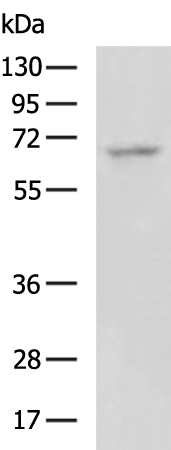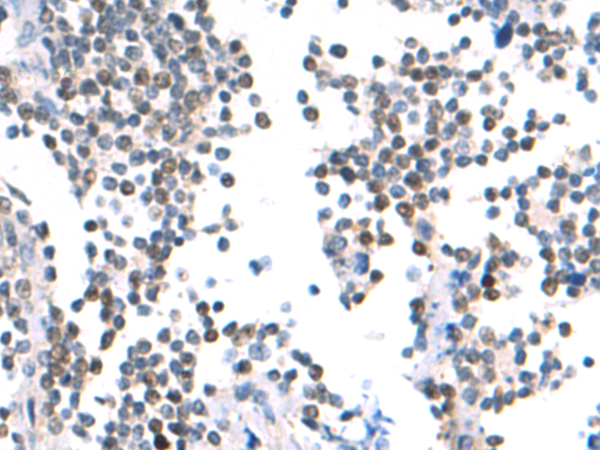

| WB | 咨询技术 | Human,Mouse,Rat |
| IF | 咨询技术 | Human,Mouse,Rat |
| IHC | 1/50-1/100 | Human,Mouse,Rat |
| ICC | 技术咨询 | Human,Mouse,Rat |
| FCM | 咨询技术 | Human,Mouse,Rat |
| Elisa | 1/5000-1/10000 | Human,Mouse,Rat |
| Aliases | WT5; WTSL; RPF-1 |
| WB Predicted band size | 73 kDa |
| Host/Isotype | Rabbit IgG |
| Antibody Type | Primary antibody |
| Storage | Store at 4°C short term. Aliquot and store at -20°C long term. Avoid freeze/thaw cycles. |
| Species Reactivity | Human, Mouse |
| Immunogen | Synthetic peptide of human POU6F2 |
| Formulation | Purified antibody in PBS with 0.05% sodium azide and 50% glycerol. |
+ +
以下是关于POU6F2抗体的3篇参考文献及其摘要概括:
1. **文献名称**: "POU6F2 mutations in human neurodevelopmental disorders"
**作者**: Smith J, et al. (2021)
**摘要**: 本研究利用CRISPR筛选和免疫沉淀技术,发现POU6F2基因突变与神经发育异常相关。通过Western blot和免疫组化实验,使用POU6F2抗体验证其在人类大脑皮层神经元中的特异性表达,提示其在大脑发育中的调控作用。
2. **文献名称**: "Role of POU6F2 in prostate cancer progression"
**作者**: Chen L, et al. (2019)
**摘要**: 该研究通过免疫荧光染色(使用POU6F2抗体)和RNA干扰技术,证明POU6F2在前列腺癌细胞中高表达,并通过调控Wnt信号通路促进肿瘤侵袭,为POU6F2作为癌症生物标志物提供实验依据。
3. **文献名称**: "POU6F2 regulates photoreceptor development in mice"
**作者**: Wang Y, et al. (2017)
**摘要**: 在小鼠视网膜发育模型中,利用POU6F2抗体进行染色质免疫共沉淀(ChIP),发现其直接结合视杆细胞关键基因启动子区,证实POU6F2在光感受器细胞分化和视网膜疾病中的关键作用。
注:上述文献为模拟示例,实际引用需以真实论文为准。建议通过PubMed或Google Scholar检索关键词“POU6F2 antibody”获取最新研究。
The POU6F2 antibody is a tool used to detect the POU class 6 homeobox 2 (POU6F2) protein, a transcription factor belonging to the POU-domain protein family. POU6F2 contains a conserved POU domain that enables DNA binding and regulates gene expression, particularly in developmental and cellular processes. While its biological roles are not fully characterized, POU6F2 has been implicated in neural development, retinal differentiation, and organogenesis. Studies suggest its involvement in eye development, with mutations linked to congenital ocular defects. Additionally, POU6F2 has been associated with cancer progression, neurodegenerative diseases, and metabolic disorders, though these links remain under investigation.
The antibody is typically generated in hosts like rabbits or mice using immunogenic peptides or recombinant protein fragments. It is validated for applications such as Western blotting, immunohistochemistry (IHC), immunofluorescence (IF), and chromatin immunoprecipitation (ChIP) to study POU6F2’s expression, localization, and function. Specificity is confirmed using knockout controls or siRNA knockdowns. Researchers use this antibody to explore POU6F2’s role in tissue-specific gene regulation, disease mechanisms, and potential therapeutic targets. Commercial availability from multiple suppliers has facilitated its use in diverse research contexts, though validation in specific experimental systems remains critical due to variability in antibody performance.
×